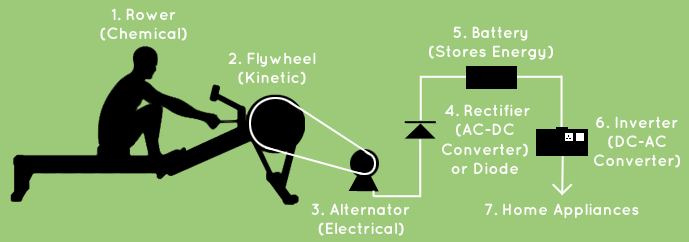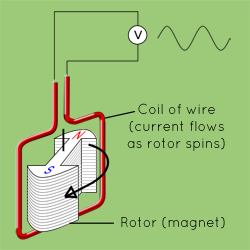 Row•er (ˈrō(-ə)r), n.: Someone with an unrelenting drive to wake up at ungodly hours and subject him/herself to the bottomless pit of pain known as an ergometer. These specimens partake in the seemingly futile activity of violently rocking to-and-fro while a smaller teammate sporting a headset screams at them to push harder.
Row•er (ˈrō(-ə)r), n.: Someone with an unrelenting drive to wake up at ungodly hours and subject him/herself to the bottomless pit of pain known as an ergometer. These specimens partake in the seemingly futile activity of violently rocking to-and-fro while a smaller teammate sporting a headset screams at them to push harder.
Masochistic as it may be, rowing is quite a self-serving exercise. But could rowers utilise their self-inflicting skills to serve the greater good? After all, an ergometer is simply an energy-transfer machine: a pulley system which converts the chemical energy in your muscles to mechanical energy that drives a flywheel. Slap on an alternator – a device that turns mechanical energy into electrical energy – and we can power our own household appliances!
If we got every rower in Oxford to connect their rowing machine to an alternator, how much electrical energy could we produce?
How It Works: The Alternator
Below is one example of many possible setups to achieve power generation using exercise equipment. It can be applied to any machine whose primary function involves rotation (e.g. rowing machines, bikes, ellipticals). Note: if you’re less interested in the technical mumbo-jumbo and are aching to find out how our Oxford rowers fared, skip to the next section.
In 1831, Michael Faraday and Joseph Henry discovered that when the magnetic field around a closed loop of wire changes, an electromotive force (a voltage) is induced in the wire. This principle, known as electromagnetic induction, underpins the operation of an alternator. The alternator consists of a rotating magnet called a rotor driven by an external force (in this case the flywheel of the rowing machine). The magnet spins within a set of fixed conductors that are wound around an outer iron core called the stator. As the rotor spins, the magnetic field through the coils changes, causing a current to flow through the conductors. The faster the rotor, the greater the current.
Alternators are most commonly found next to a car’s engine. A device known as a crankshaft converts the translational motion of the engine’s pistons into a rotational motion that drives the rotor. Whenever a car’s onboard circuitry stops working – headlights, ignition, air conditioning, and so on – people immediately attribute the problem to battery depletion. However, it is often neglected that the alternator breathes life into the battery, providing the necessary electrical energy to charge it. Next time your car dies on the way to work, consider the possibility that the alternator, not the battery, may have taken its last breath.
Alternators are sometimes referred to as AC generators because they produce alternating current (where current periodically reverses direction). Since a battery only produces direct current (DC), a rectifier is needed to convert the AC signal from the alternator to a DC signal before it reaches the battery. Nowadays, rectifiers are included within the alternator itself.
The beauty of a battery is its ability to store (chemical) energy, which can be harnessed later on. However, household appliances that plug into the mains sockets in your wall use alternating current (which is safer and more efficient to transfer over long distance power lines to your house). Consequently, a final component known as an inverter is needed to convert the DC signal from the battery back into AC.
It’s Crunch Time!
Back to rowing. 179 crews competed in last year’s Summer Eights races. Let us assume that each of the 1432 rowers at the event trained 1 hour per week on an ergometer, or eight hours over the course of Trinity. This means that a cumulative total of 11,400 hours was spent tugging furiously at a handle last term (a conservative estimate!).
How Much Power?
We can make rough estimates of the efficiency of the circuit components:
- Alternator: 60%
- Inverter: 85%
- Battery (storage): 90%
- Losses due to friction: negligible
Thus, we obtain an overall efficiency of about 45% (in other words, just under half of the mechanical energy in the flywheel is converted to electrical energy). Assuming that the rowers held a steady and moderate pace of 2:12 minutes per 500m on the rowing machine, we are told that this equates to a mechanical power output of 150 watts. However, factoring in the efficiency of our system, only 68 watts of electrical power are output – enough to power a lightbulb.
These numbers represent a single rower producing 68 joules of energy per second. If all Oxford rowers followed the training schedule outlined above, they would collectively generate 790 kilowatt hours (kWh) of energy per term.
What does this mean? The average annual electrical energy consumption in UK households is reportedly 3,300 kWh. Despite their best efforts, the Oxford rowers would not meet this demand after a full academic year’s worth of training. In fact, six or more rowers would have to row continuously to power a house, and even then at a pace that is impossible to sustain over long periods. Alternatively, Kiwi athlete Rob Waddell could alone power a household for a year by rowing at his world record 2km pace for 235 days and covering a distance of 3 Earth circumferences. A tad unrealistic.
But let’s think bigger. How many Oxford rowers would it take to power New York City? A whopping army of 74 million – more than the entire population of the UK!
Energy 2.0?
Whilst this article provides some interesting facts about rowing, it also raises a serious question: is there any scope for human-generated electricity? In an era where the debate on sustainability and clean energy is becoming increasingly prominent, it would be refreshing to see innovations that give people the ability to power their own home. The notion of everyday human activity having external and societal benefits has profound scope that extends beyond the developed world. Consider, for example, a children’s carousel that pumps water in the Third World.
The technology for energy-generating exercise machines already exists, and people-powered gyms have begun to emerge in the developed world. However, human power generation schemes are ultimately limited by their cost and efficiency, as the energy gains are small when compared to the cost of retrofitting existing exercise equipment. Addisson Killean Stark of MIT argues that multiple steps of energy conversion are required to realise machine-based electricity (from solar to chemical, chemical to mechanical, and mechanical to electrical), resulting in energy degradation and hence low efficiency. It is therefore difficult to judge whether green gyms are driven by a moral conscience or the business opportunity to attract today’s growing environmentally aware demographic.
Perhaps it’s too early to predict the future of such energy schemes – after all, people prematurely believed that solar and wind power were too expensive to take off. However, until we’ve developed a cost effective, high efficiency solution for retrofitting household equipment, we’re probably better off investing in solar panels.
![How Many Rowers Does It Take to Power a Lightbulb? Row•er (ˈrō(-ə)r), n.: Someone with an unrelenting drive to wake up at ungodly hours and subject him/herself to the bottomless pit of pain known as […]](/wp-content/uploads/2012/10/how-much-cover-620x300.png)

